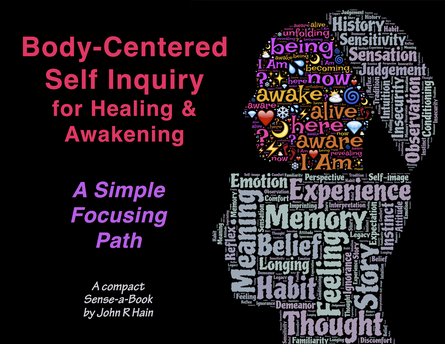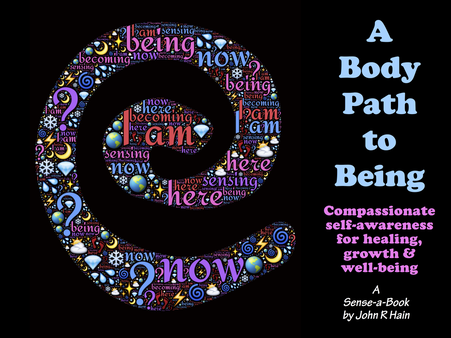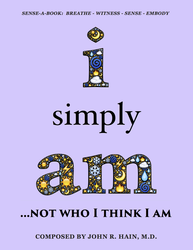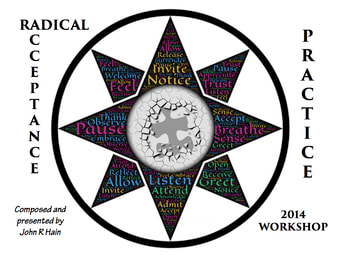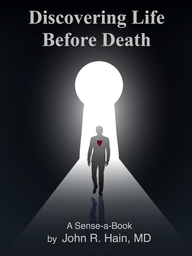|
Click on the flyer photo below or here to view slide show
Workshop Guided Meditation Exercises:
Exercise 1: Exploring Personal Orientation to Insecurity
1) Assume a comfortable position that can be maintained for 20 minutes. 2) Affirm that right now, in this place, you are OK no matter what feelings or thoughts are being experienced. Decide to meet and hold whatever arises with unconditional attention, acceptance, appreciation, affection, and allowing (5A s). 3) Set your body at ease. Use slow abdominal breathing. Sense into your body, beginning with feeling how it relaxes into what supports it. Then very slowly sense all aspects of your: feet, legs, hips, hands, arms, shoulders, neck, back, scalp and face, space inside your head. Next breath & very slowly sense inside the throat, chest, abdomen, making space for anything to enter awareness. 4) Slowly repeat to yourself the following phrase: I am safe, I matter, I belong, no matter what. Notice whatever arises inside irregardless of form (sensation, emotion, image, thought, judgement, memory, metaphor, impulse, tension etc). 5) Welcome each element, giving it time and room to develop. Curiously, patiently, be with it, allowing it to be as it is, noticing what it is like. Sense what it may be offering or revealing. Notice anything else that arises in relation or reaction to it. 6) Notice anything that gets in the way of fully accepting, as it is, whatever is being experienced. Listen for the judgments, worries & concerns: What is most feared. What is most longed for. Appreciate any protective or supportive nature of its role (how it has tried to help in some way). Notice what it reminds you of from childhood and sense into any other associations. 7) Repeat steps 4, 5, & 6 as needed to stay engaged or re-engage with body. 8) Create a loving space to hold, without judgment, all the components of your internal experience, free of any need to analyze or figure it out. Allow yourself to be affected and to integrate it without explanation. 9) Survey your body and note anything that differs from when you started. Appreciate your body. Let it know you will return to attend it in this way. Slowly bring your attention back to the room. Take out your syllabus and write down or symbolize the forms of F-T-R that were experienced and note any links between them (e.g. feeling - memory - response) 10) Choose a listening partner. Describe your session experience, using notes as needed (5 min. each, without interruption).
Exercise 2: Exploring & Resourcing the Bodily Aliveness
1) Assume a comfortable position that can be maintained for 20 minutes. 2) Affirm that right now, in this place, you are OK no matter what feelings or thoughts are being experienced. Decide to meet and hold whatever arises with unconditional attention, acceptance, appreciation, affection, and allowing (5A s). 3) Set your body at ease. Use slow abdominal breathing. Sense into your body, beginning with feeling how it relaxes into what supports it. Then very slowly sense all aspects of your: feet, legs, hips, hands, arms, shoulders, neck, back, scalp and face, space inside your head. Next breath & very slowly sense inside the throat, chest, abdomen, making space for anything to enter awareness. 4) Remember a time, in early childhood, you felt most alive, enthusiastic, or free. Recall the circumstances, setting, what it felt like. Sense your body as you recall even more details of the memory and any associated feelings, thoughts, responses (F-T-R). Curiously and compassionately be with whatever is being sensed, offering each one lots of time and space to develop. 5) Notice whatever else arises in relation to it, be it sensation, emotion, image, thought, judgement, memory, metaphor, movement, posture etc. Invite it to reveal more. Especially welcome any opposing, competing, or confusing judgments, attitudes, or feelings, & what they remind you of from long ago. Get a sense if they are somehow adaptive/protective, & how they were adopted. Appreciate them & the role they served. 6) Stand upright, silently but emphatically decide I am fully alive! and take a fully alive posture. Sense into and be with whatever arises internally in reaction to the affirmative decision and posture. Welcome any familiar patterns of opposing F-T-R. Get a sense if they are adaptive or protective in any way, and how. If so, appreciate them and their role. Next sense into the core of your body and be with its deepest longings/yearnings or doubts/fears regarding aliveness, and once again silently but emphatically decide I am fully alive! Allow your body to experience its aliveness. 7) Create a loving space to hold, without judgment, all the components of your internal experience, free of any need to analyze or figure it out. Allow yourself to receive and integrate it all without it having to make sense. 8) Survey your body and note anything that differs from when you started. Appreciate your body. Let it know you will return to attend it in this way. Slowly bring your attention back to the room. Take out your syllabus and write down or symbolize the forms of F-T-R that were experienced and note any links between them (e.g. feeling - memory - response). Hold whatever feelings arise in non-judgmental with-ness. 9) Find a listening partner. Describe your session experience, using notes as needed (5 min. each, without interruption).
Exercise 3 : Exploring A Personal Limitation/Impasse
1) Assume a comfortable position that can be maintained for 30 minutes 2) & 3) As in previous exercises above. 4a) Make a welcoming space for anything to enter awareness in relation to the limitation of moving forward. Sense into what is wanted and/or what is not wanted. A part of me is wanting something. Sense into what your body is wanting, hoping or expecting to feel or to happen by moving ahead. Go for the deepest longings in the most vulnerable places. Make room for it to reveal fully. Notice what it reminds you of from long ago. Hold whatever feelings arise in non-judgmental with-ness. 5a) Inquire into reluctance, worry, concern. Another part of me may be holding back for fear of something. Sense into what your body fears happening and/or feeling in the process. Go for the deepest fears (dread) in the most vulnerable places. Notice what it reminds you of from long ago. Hold whatever feelings arise in non-judgmental with-ness. 4b) Inquire into any possible competing urges. Perhaps another part of me is wanting something else instead. Sense into what your body is wanting, hoping or expecting to feel or to happen by taking this road. Go for the deepest longings in the most vulnerable places. Make room for it to reveal fully. Notice what it reminds you of from long ago. Hold whatever feelings arise in non-judgmental with-ness. 5b) Again inquire into reluctance, worry, concern. Another part of me may be holding back for fear of something else. Sense into what your body fears happening and/or feeling from this choice. Go for the deepest fears (dread) in the most vulnerable places. Notice what it reminds you of from long ago. Hold whatever feelings arise in non-judgmental with-ness. 6) Acknowledge and take note of self-judgments that arise in relation to any of the wanting/longing. A part of me says I should want _____ or should feel _____. Sense into any attitude or feelings associated with it and the role it serves. Appreciate any protective nature of its role. Notice what it reminds you of from childhood and any associated feelings or bodily sensations. Another part of me says I should not want _____ or I should not feel ______. Sense into any attitude or feelings associated with it and the role it serves. Appreciate any protective nature of its role. Notice what it reminds you of from childhood. 7) Create a loving space to hold, without judgment, all the components of your internal experience, free of any need to analyze or figure it out. Allow yourself to be affected and to integrate it without explanation. 8) Survey your body and note anything that differs from when you started. Appreciate your body. Let it know you will return to attend it in this way. Slowly bring your attention back to the room. Take out your syllabus and write down or symbolize the forms of F-T-R that were experienced and link any relationships among them. 9) Choose a listening partner. Describe your session experience, using notes as needed (5 min. each, without interruption).
Record notes for what arose during each exercise
THOUGHTS (mental) Judgments, Memories, Attitudes FEELINGS (visceral) Sensations, Emotions, Energy ​ RESPONSES (physical) Impulses, Tensions, Postures
0 Comments
|
SENSE-A-BOOKS:
view free now Archives
March 2024
CategoriesAll 5 A's Discovering Life Before Death Discovering Wholenesss Identity Mission Statement Radical Acceptance Practice Redefine Life Expectancy Self Image Suffering Happens Thoughts-feelings Transcending-suffering |
Search by typing & pressing enter

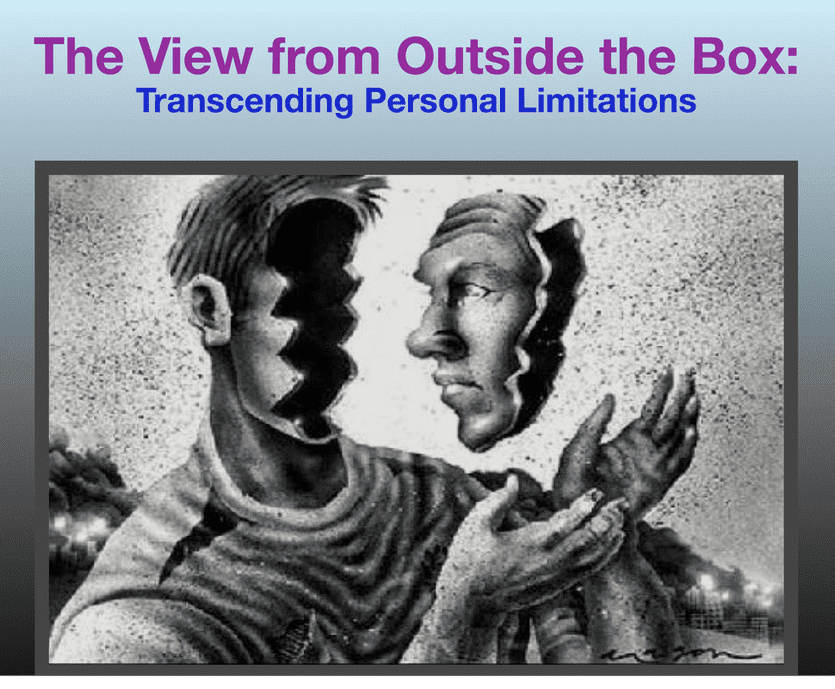
 RSS Feed
RSS Feed
